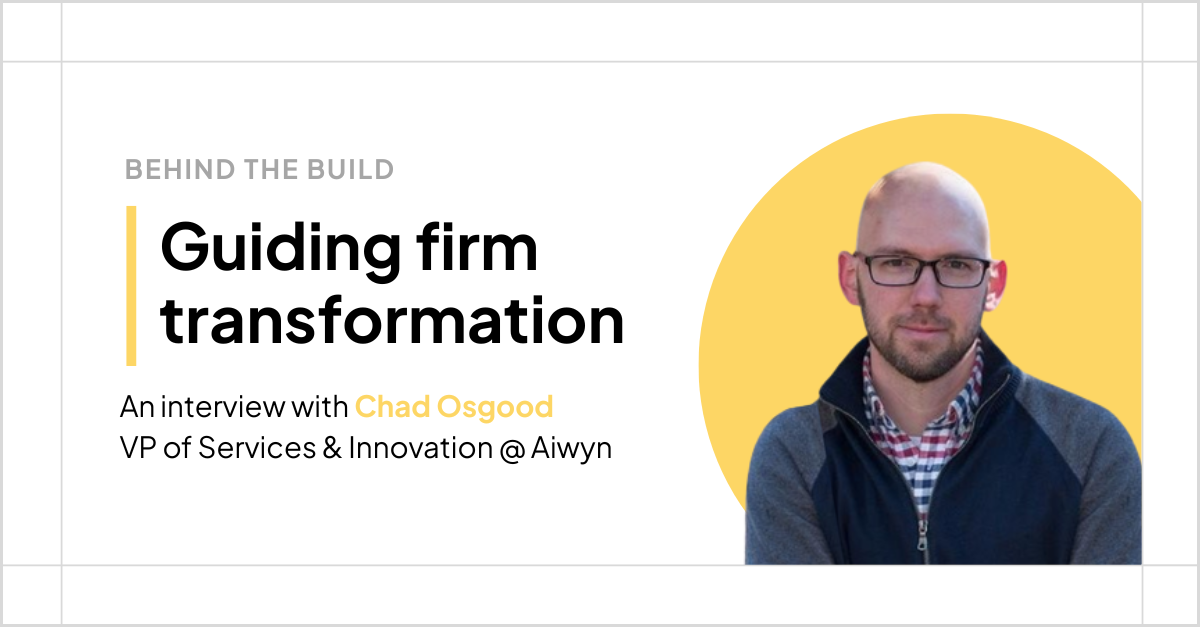Chad Osgood joined Aiwyn through a recent acquisition, but he’s no stranger to the challenges accounting firms face when it comes to technology. With a background rooted in consulting and firm enablement, Chad brings a thoughtful, strategic lens to his new role at Aiwyn, where he’ll play a key part in helping firms chart a clear path forward.
In this edition of Behind the Build, Chad shares how he’s approaching firm transformation, why a consultative mindset matters more than ever, and what it takes to build a modern technology roadmap that aligns with where firms are headed—not just where they’ve been.
Q: You recently joined Aiwyn through an acquisition. Can you share a bit about your journey and what drew you to this next chapter?
A: My background is a mix of entrepreneurship, technology, and deep exposure to the accounting profession. Over the years, I’ve built and sold multiple companies focused on solving fundamental challenges that block innovation and transformation. Digilence was launched to help firms where they needed it most: integrating systems, consolidating data, automating complex workflows, and unlocking time savings.
I got into accounting by way of Microsoft and the Big Four, initially helping firms respond to the audit impact of Sarbanes-Oxley. That work led to years in the trenches with firms of all sizes, helping them navigate regulatory change, growth, technology transformation, and acquisitions. I've seen firsthand what becomes possible when an entrepreneurial mindset is applied inside firms.
Joining Aiwyn was about seizing the opportunity in a profession that is evolving fast. Aiwyn is one of the few companies with the appetite, talent, and platform to create the real, lasting change the profession needs. The opportunity we began chasing with Digilence, what we called powering the “Digital Firm,” was only growing. Joining a market leader with the right cultural fit was the right move.
Q: What will your new role focus on, and how will it help firms approach transformation more strategically?
A: My role is to help firms make transformation real - to move beyond strategy on paper and facilitate execution that sticks. In my experience, firms don’t lack ideas, they struggle with alignment, follow-through, and most often, knowing where to start. How do you build a strategy that connects payments, practice management, CRM, and data? What about the internal tools you’ve already built? How does it all integrate and how do you improve what’s broken without disrupting what works?
There are simply too many moving parts and too little clarity. That’s why transformation often stalls. By helping firms define what transformation means to them, it becomes easier to turn that into practical, achievable steps everyone can get behind.
Q: A lot of firms are rethinking their technology roadmaps. Where do you recommend they start?
A: Start wide. Change is hard to motivate when people feel excluded from the process. Engage stakeholders across every service line and support function: IT, finance, HR, operations. Don’t just gather input from leadership. Some of the most valuable insights live with the people closest to the work. Unlocking this hidden intelligence comes down to two simple things: listening and empathy. It won’t feel immediately productive, but it’s essential.
From there, look for clear opportunities and early wins. Focus on traction, not perfection. When I work with Aiwyn customers, I often say, “Don’t worry about the middle at the beginning. Just get started.”
Q: What are some of the biggest blockers firms face when trying to modernize their operations?
A: The biggest blocker is the status quo. Change is hard, and sticking with what’s familiar, even if it’s inefficient, can feel safer than choosing something new that carries risk.
Modernization is often associated with replacing technology when it should actually be viewed as a actually a holistic shift involving people, processes, tools, and the historical context that shapes how work gets done. This includes outdated data, entrenched habits, and the pressure to meet day-to-day demands without disruption. Because of this, there’s never a “good” time to start, so firms don’t.
It’s important to clearly separate innovation from daily operations. Give it space to breathe. Treat modernization like a factory designed to build change and deliver value systematically. Then focus on integrating those changes without expecting it to be seamless. There’s no such thing as frictionless change, but you can reduce resistance by keeping stakeholders engaged from beginning to end.
Q: What do you think the most forward-looking firms are doing right now that others aren’t?
A: They’re treating transformation as a permanent function, not a temporary project. That means aligning leadership, defining a clear vision, and giving transformation a real seat at the table. Ensure it’s a strategic priority owned across the firm. Don’t let it be something delegated to IT or innovation teams.
Forward-looking firms also recognize the profession is changing around them. With private equity entering the space, accounting is becoming more like an industry. That brings structure, governance, and performance expectations that feel new to many firms. But the firms that lean into this shift instead of resisting it are the ones positioning themselves for long-term strength.
Q: What’s a misconception firms often have about “transformation” or building a tech stack?
A: Many firms are chasing the idea of the “perfect” tech stack. But the perfect stack doesn’t exist. Unless you’re building a firm from scratch, legacy is part of your reality. You have to work from where you are, not from a blank slate.
That means you can't just pick tools, map out a plan, and move on. You have to build a resilient system where technology, people, and process are aligned and able to adapt as the market evolves. Change isn’t a disruption to manage. It’s a capability to develop.
If transformation feels like a one-time project, a tech selection exercise, or something that lives on a roadmap for a calendar year, that’s the clearest sign the wrong mindset is in play.
Q: You’ve worked closely with firms for years. What changes have you seen in their expectations from tech vendors?
A: Firms used to evaluate technology in silos. If it solved a tax or audit problem, that was enough. Now, the bar is much higher. They expect solutions to work across the entire firm and not just one team. They ask deeper questions: How does this integrate with our other systems? Will it create friction for HR, IT, or operations? What’s the total cost of ownership, not just the license fee?
There’s also a shift in how firms view their vendors. Beyond software, they’re looking for strategic partners who understand the profession, anticipate needs, and reduce complexity, not add to it.
Q: What excites you most about being part of Aiwyn at this stage of its growth?
A: The profession is hitting a turning point. Firms know they need to modernize, but many don’t know how to start or what to prioritize. Aiwyn is in a rare position to lead, not just with software, but with clarity, support and helping firms transform.
We’re small enough to move fast and experiment, but big enough to create real leverage for our customers. We have great capital partners, a great team and a clear vision to be a generational company. That’s a once-in-a-career opportunity.
I’ve spent my career building solutions for this profession, launching companies, products and being in the trenches of transformation and innovation. At Aiwyn, I get to do that with the right team, at the right moment, with the resources to make a meaningful dent. That’s what makes this exciting.




